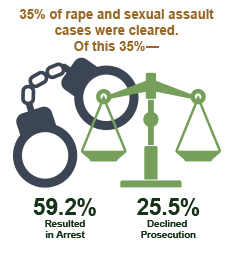7. Data on Case Clearances
| Percent of cleared cases that resulted in— | ||||||||
|---|---|---|---|---|---|---|---|---|
| Percent of incidents— | Exceptional clearance due to— | |||||||
| Most serious violent offense/a | Total | Not cleared | Cleared | Total | Arrest | Declined prosecution | Victim refusal to cooperate | Other reason/b |
| Murder/non-negligent manslaughter | 100% | 43.9 | 56.1 | 100% | 91.4 | 1.1 | 0 | 7.4 |
| Rape/sexual assault | 100% | 65.5 | 34.5 | 100% | 59.2 | 25.5 | 13.8 | 1.5 |
| Robbery | 100% | 75.4 | 24.6 | 100% | 84.8 | 5.3 | 9.6 | 0.4 |
| Aggravated assault | 100% | 47.5 | 52.5 | 100% | 86.0 | 5.2 | 8.3 | 0.5 |
The traditional Uniform Crime Report collects almost no data on the details of criminal incidents. NIBRS overcomes this limitation by collecting arrest information as well as information regarding victim demographics (e.g., age, sex, race, ethnicity, relationship to offender), the offense(s) that occurred, offender(s), weapon used, property stolen, and other variables. Through NIBRS, law enforcement officers can track cases and update their files any time NIBRS receives new information (e.g., when an arrest is made, regardless of how long ago the victimization occurred). NIBRS also can provide data on case clearance rates for specific crimes.
As shown in the table above, only 24.6 percent of robberies were cleared, whereas 91.4 percent of murder/non-negligent manslaughter cases were cleared.1, 2 The table also provides information on how cases were cleared. For example, of the 34.5 percent of rape and sexual assault cases that were cleared, 25.5 percent were due to declined prosecution. In contrast, of the 52.5 percent of aggravated assault cases that were cleared, prosecution declined only 5.2 percent of cases. Of the 34.5 percent of rape and sexual assault cases that were cleared, 59.2 percent were due to arrest and 13.8 percent were due to victims refusing to cooperate. Victim refusal to cooperate accounted for only 8.3 percent of cleared aggravated assault cases. Service providers and law enforcement can use this data for accountability purposes and self-assessment.
1Law enforcement agencies reporting crimes to the Federal Bureau of Investigation can clear, or "close," the offenses in one of two ways: by arrest or by exceptional means. www.fbi.gov/about-us/cjis/ucr/crime-in-the-u.s/2010/crime-in-the-u.s.-2010/clearances
2.In the 15 fully reporting NIBRS states.







